
Source: Ngorongoro Crater - North Tanzania, sambukot, Flickr
Third-Person Objective
Third-person objective narration is similar to third-person limited, and sometimes it is easy to confuse the two. As you will recall from the last section, the third-person limited point of view allows the reader access to what one character, usually the protagonist, sees, feels, hears, and thinks. Third-person objective point of view does not allow access to any of the characters’ thoughts or feelings. It’s as if the reader were on the scene, observing the action. If you were sitting on a park bench, listening to a couple squabble about whose turn it was to do the dishes, you would only know about them and their relationship what you observed with your own eyes and heard with your own ears. You wouldn’t know what either of the people was thinking or feeling—although you might be able to guess! That’s how it is with third-person objective narration. Here is an excerpt from “The Lottery” by Shirley Jackson.

Source: Will performing at the Little Red School House, steven_d_krause, Flickr
The children assembled first, of course. School was recently over for the summer, and the feeling of liberty sat uneasily on most of them; they tended to gather together quietly for a while before they broke into boisterous play, and their talk was still of the classroom and the teacher, of books and reprimands. Bobby Martin had already stuffed his pockets full of stones, and the other boys soon followed his example, selecting the smoothest and roundest stones; Bobby and Harry Jones and Dickie Delacroix—the villagers pronounced this name “Dellacroy”—eventually made a great pile of stones in one corner of the square and guarded it against the raids of the other boys. The girls stood aside, talking among themselves, looking over their shoulders at the boys, and the very small children rolled in the dust or clung to the hands of their older brothers or sisters.
This narration doesn’t follow a specific character as does the third-person limited point of view we looked at earlier. Neither do we learn any of the characters’ thoughts. We experience the story as we would if we watched the events unfold ourselves. It’s helpful to think of the third-person objective point of view as like watching a movie. Unless a movie has voice-over narration, the viewer observes the events firsthand and gets information at the same time the characters do.
How might the third-person objective point of view build suspense in a story?

Respond using your notes. When you are finished, check your understanding.
Sample Responses:
This point of view supports the suspenseful nature of the story. We don’t know anyone’s thoughts, so we’re never sure what’s going to happen. If we were able to read their thoughts, we would know what the children are thinking and feeling, which could spoil the suspense.
Third-Person Omniscient

Source: Ростова пастернак, Leonid Pasternak, Wikimediar
In the third-person omniscient point of view, the narrator has access to the thoughts and feelings of all characters. The omni- prefix means “all” and -scient means “knowing.“ The omniscient narrator is all-knowing. Third-person omniscient point of view should not be confused with multiple point-of-view characters. Sometimes a novel, and rarely a short story, is told from the point of view of multiple characters, with the writer switching off among narrators between sections or chapters. This is different from an omniscient narration; with third-person omniscience, the narrator is not a participant in the story but has access to all of the thoughts and feelings of all the characters.
The third-person omniscient point of view is rarely used in short stories for two reasons. First, the omniscient point of view fell out of style in fiction and many consider it old-fashioned. Second, it is just too difficult to tell a good short story in the omniscient point of view. Here is an example of third-person omniscient narration from the novel Pride and Prejudice by Jane Austen.
The Bennets have just been to a dance and acquainted themselves with a new neighbor, Mr. Bingley. It is Mrs. Bennet’s hope that Mr. Bingley will show some interest in marrying her oldest daughter, Jane. The following scene occurs just after the end of the party. Try to find the sentences where we shift into different characters’ thoughts. Click on each one you find, and the sentence will highlight.
The evening altogether passed off pleasantly to the whole family. Mrs. Bennet had seen her eldest daughter much admired by the Netherfield party. Mr. Bingley had danced with her twice, and she had been distinguished by his sisters. Jane was as much gratified by this as her mother could be, though in a quieter way. Elizabeth felt Jane’s pleasure. Mary had heard herself mentioned to Miss Bingley as the most accomplished girl in the neighbourhood; and Catherine and Lydia had been fortunate enough to be never without partners, which was all that they had yet learnt to care for at a ball. They returned, therefore, in good spirits to Longbourn, the village where they lived, and of which they were the principal inhabitants. They found Mr. Bennet still up. With a book he was regardless of time; and on the present occasion he had a good deal of curiosity as to the event of an evening which had raised such splendid expectations. He had rather hoped that all his wife’s views on the stranger would be disappointed; but he soon found that he had a very different story to hear.”
Hold the mouse over the highlighted sentences or phrases in the excerpt. Each signals the narrator’s ability to relate the point of view of one of the characters. The first highlight explains Mrs. Bennet’s feelings about the party. The next one shows Jane’s feelings followed by Elizabeth’s. We move from her to Mary and what she overheard and then to the cares of Catherine and Lydia. The last sentence shows Mr. Bennet’s thoughts.
If this novel had been written from a first-person point of view, or from third-person limited or objective, the only way the author could convey this much information about how characters feel would be to include a section of dialogue. Each character could speak about how he or she felt about the evening’s events. However, the narrator knows all of this and can impart it in a single paragraph.
Now let’s practice identifying all of the types of point of view.